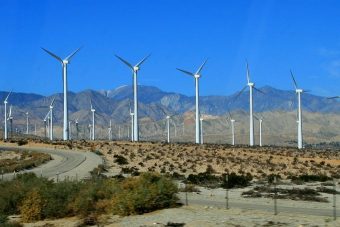
The dramatic collapse in renewable energy costs is showing no sign of abating, according to the latest report from Bloomberg New Energy Finance (BNEF).
The influential analyst firm yesterday published its annual New Energy Outlook (NEO) Report, setting out its projections for the global clean energy market through to 2040.
It predicts solar power costs are set to fall a further 66 per cent by 2040, while onshore wind energy costs are expected to fall 47 per cent. As a result, renewables are tipped to undercut the majority of existing fossil fuel power stations as early as 2030.
The sharp cost reductions prompted BNEF to bring forward the date it expects emissions from the world’s power system to peak to 2026. However, it acknowledged a further acceleration of the clean energy market will be required to meet the emissions goals set out under the Paris Agreement.
Seb Henbest, lead author of NEO 2017 at BNEF, said the report suggests that “the greening of the world’s electricity system is unstoppable, thanks to rapidly falling costs for solar and wind power, and a growing role for batteries, including those in electric vehicles, in balancing supply and demand”.
The report is based on announced project pipelines around the world and forecasts for the economics of electricity generation and power systems.
It concludes solar and wind will “dominate the future of electricity” with $7.4tr invested in new renewable energy plants through to 2040.
The report comes in the same week as the latest statistical review from BP, which detailed how coal demand is falling as renewables continue to retain their position as the fastest growing energy source. It also came as a survey from Deloitte revealed overwhelming public and business backing for new clean energy projects in the US.
BNEF predicts renewables dominance of the energy will continue, with renewables accounting for 72 per cent of the $10.2tr that is projected to be spent on new power generation worldwide through to 2040.
Solar is expected to attract $2.8tr of investment as capacity grows 14-fold, while wind projects are tipped to attract $3.3tr as capacity grows four-fold.
Overall, wind and solar are expected to make up 48 per cent of the world’s installed capacity by 2040, delivering 34 per cent of electricity generation.
The report assumes energy policies around the world “remain on their current bearing”, but it also expects subsidies to play less of a role in the clean energy market in the future as costs continue to fall.
“Solar is already at least as cheap as coal in Germany, Australia, the US, Spain and Italy,” BNEF said. “By 2021, it will be cheaper than coal in China, India, Mexico, the UK and Brazil as well.
Similarly onshore and offshore wind costs are expected to keep falling, with offshore costs expected to drop a “whopping” 71 per cent by 2040.
The report is also optimistic many of the challenges presented by the intermittent nature of wind and solar power can be overcome through the use of batteries and new technologies for delivering grid flexibility.
BNEF predicts the lithium-ion battery market for energy storage will be worth at least $239bn between now and 2040, while electric vehicles are also expected to play a major role in providing grid balancing services.
“This year’s forecast shows EV smart charging, small-scale battery systems in business and households, plus utility-scale storage on the grid, playing a big part in smoothing out the peaks and troughs in supply caused by variable wind and solar generation,” said Elena Giannakopoulou, lead analyst on the NEO 2017 project.
Consequently, BNEF predicts a bleak outlook for the global coal industry. Coal use is expected to fall 87 per cent and 45 per cent in the US by 2040, while coal use in China is predicted to peak in 2026.
“Globally, we expect 369GW of planned new coal plants to be cancelled, a third of which are in India, and for global demand for thermal coal in power to decline by 15 per cent over 2016-40,” BNEF said.
The firm also expresses scepticism President Trump can deliver on his goal of reviving the US coal industry. “NEO 2017 indicates that the economic realities over the next two decades will not favor US coal-fired power, which is forecast to see a 51 per cent reduction in generation by 2040,” it said. “In its place, gas-fired electricity will rise 22 per cent, and renewables 169 per cent.”
BNEF predicts gas will play a role in the global power mix as a “transition fuel”, but argues its main market will be provided by peaking plants, rather than baseload power plants.
The net result is BNEF thinks global power sector emissions will decline from 2026 onwards, but it warns further action is needed by governments and businesses to bring the sector into line with the temperature goals agreed in the Paris Agreement.
“Globally, emissions will have dropped to four per cent below 2016 levels by 2040, not nearly enough to keep the global average temperature from rising more than 2C,” BNEF states. “A further $5.3tr investment in 3.9TW of zero-carbon capacity would be consistent with keeping the planet on a 2C trajectory.”
However, there are some reasons to be optimistic this further investment can be mobilised. A number of countries have already signalled they will strengthen their climate policies in the wake of the Paris Agreement, while BNEF’s report provides an insight into how quickly projections for the clean energy sector can change.
The firm said it now expects India’s emissions in 2040 to be fully 44 per cent lower than it predicted in last year’s report thanks to the government’s plans to invest $405bn in delivering 660GW of new solar PV capacity.
Source: businessgreen.com



